Buzz Brands are wines that are sure to turn heads, destined to cause a stir whenever they are opened. They combine excellence across Wine Lister’s two Brand criteria – restaurant presence and online popularity – whilst also being held in the highest regard by the fine wine trade – as confirmed by Wine Lister’s Founding Members’ survey which gathers the opinions of around 50 key players in the international wine trade. This week, the Listed section focuses on Italy’s top five Buzz Brands by overall Wine Lister score.
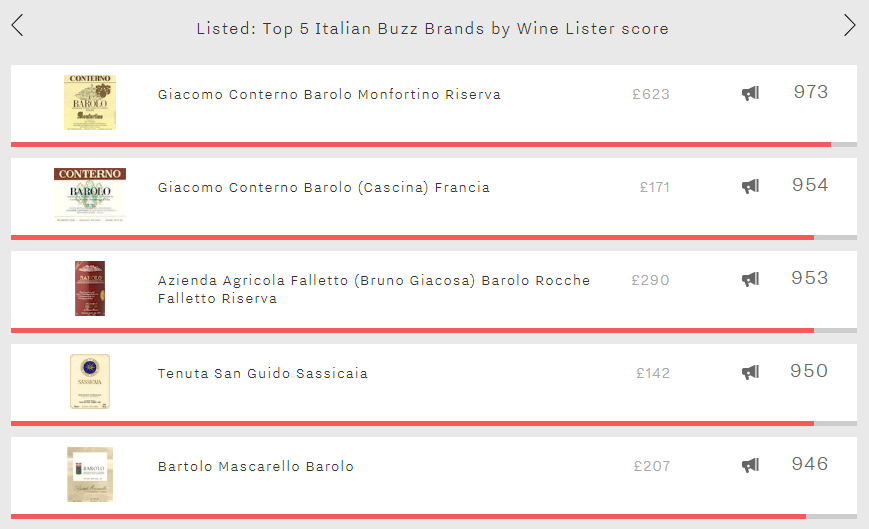
Barolo is home to four of Italy’s top five Buzz Brands, two of which are produced by Giacomo Conterno – the flagship Monfortino in first place (973) and Francia not far behind in second place (954). The Monfortino achieves Italy’s best Quality score (977), the result of remarkable consistency from vintage to vintage, having achieved a score of 993 or above in seven of the past 10 vintages. Its best ever vintage was 2004 (998), thanks to a perfect 100-point score from Antonio Galloni, who writes: “I imagine the 2004 Monfortino will give readers an utterly spellbinding drinking experience for the next few decades”.
Whilst the Francia is pipped at the post in each category by its illustrious stablemate (trailing by 17 points in the Quality category, 11 in the Brand category, and 34 in terms of Economics), it does manage superior restaurant presence, visible in 30% of the world’s top establishments, compared to the Monfortino’s 23%. This is presumably due to over three times as many bottles of it being produced each year on average.
In third place is Azienda Agricola Falletto’s Rocche Falletto Riserva (953). It records the best Economics score of the five (969) and Italy’s second-best, beaten only by Falletto’s Barbaresco Asili Riserva (978). It does so thanks to the combination of very strong growth rates – it has recorded a three-year compound annual growth rate of 21% and has added 8% to its value over the past six months alone – and strong liquidity – its top five vintages having traded 398 bottles at auction over the past year. Perhaps collectors have been eager to get their hands on a bottle after the passing of Bruno Giacosa in January.
Proving that Super Tuscans can mix it with Piedmont’s top nebbiolos, Sassicaia takes fourth place. Whilst it cannot keep pace with Barolo’s finest in the Quality and Economics categories, Sassicaia stretches out a comfortable lead in the Brand category thanks to an extraordinary score of 998. This near-perfect score puts it alongside Haut-Brion, Margaux, and Petrus, beaten only by the Pauillac First Growths, Dom Pérignon Vintage Brut, and Yquem. Its brand dominance is the result of outstanding restaurant presence (49%) and online popularity – receiving well over three times as many searches each month as Conterno’s Monfortino, which is the group’s second-most popular wine.
Rounding out the five is Bartolo Mascarello’s Barolo. Its brand is its strongest asset, its score of 964 making it Barolo’s second-strongest brand behind Conterno’s Monfortino. Despite receiving over 20% fewer online searches each month than the Monfortino, it matches its level of restaurant presence – perhaps the azienda’s famous “no barrique no Berlusconi” message strikes a chord with sommeliers.
This week’s Listed blog will for most be an exercise in window shopping (or perhaps lèche-vitrine might be more appropriate). Not just the eye-watering prices, but also the extreme rarity of this week’s top five – just 500 bottles of d’Auvenay’s Chevalier-Montrachet are produced each year – act as bouncers stopping all but the most fortunate from entering this exclusive Burgundian showroom. Nevertheless, we can at least vicariously get as close to Chardonnay nirvana as possible with the Côte de Beaune’s five most expensive wines.
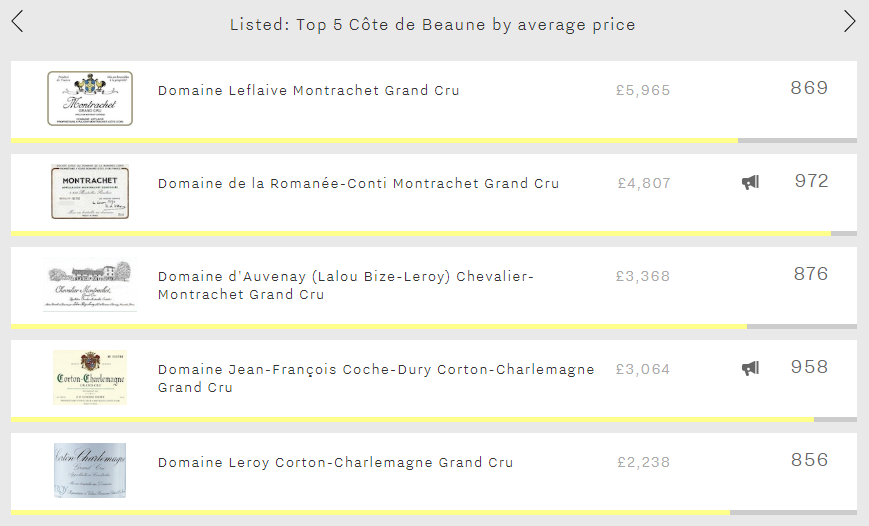
And these five really do get close to Chardonnay perfection, with a remarkable average Quality score of 975, putting them all amongst the top 15 still dry whites for Quality on Wine Lister. Perhaps reassuringly, Leflaive’s Montrachet, the Côte de Beaune’s most expensive wine, achieves the group’s best Quality score (985). 2010 was its best ever vintage, with a Quality score of 990, Jancis Robinson awarding it 19.5/20 and calling it: “[…] Not rich but gorgeous. Pale gold and obviously much fuller and deeper than Leflaive’s other grands crus. Rich yet so fresh! Nutty. Amazing concentrated fruit has already triumphed over the new oak. Very racy […]”. Interestingly, at £4,400 per bottle the 2010 is currently priced below all recent vintages other than the 2003.
Descending from the dizziest of heights, in second place is DRC’s Montrachet (£4,807). It is not just the Côte de Beaune’s overall top-scoring wine, but the best still dry white on Wine Lister (972). It is remarkably consistent across each of Wine Lister’s three rating categories, with Quality, Brand, and Economics scores of 975, 960, and 987 respectively. It is its Brand score that helps it nudge ahead in this Côte de Beaune showdown, with Coche-Dury’s Corton-Charlemagne the only one of the group to get close (924), the other three lagging c.250-290 points behind. Its brand superiority is the result of dominating both in terms of restaurant presence (visible in 26% of the world’s best establishments, comfortably above the Coche-Dury’s 19%) and online popularity (receiving 65% more searches each month than the Coche-Dury).
Whilst the Coche-Dury can’t quite match DRC’S Montrachet in the Brand or Quality categories, it does achieve the same phenomenal Economics score (987), having registered a superior three-year compound annual growth rate (25% vs 22%) and being the most-traded of the group at auction.
Lalou Bize-Leroy features twice in the list, first with d’Auvenay’s Chevalier-Montrachet (£3,368) and secondly with Domaine Leroy’s Corton-Charlemagne (£2,238). If ever there was proof of the life-altering potential of these hallowed wines, of his first taste of d’Auvenay’s Chevalier-Montrachet 1996, Wine Lister’s newest partner critic Neal Martin writes: “I took a large sip. It was like a thunderbolt hitting my senses: the tension, the complexity and intensity sent shivers down my spine. It was difficult to put down in words, yet this wine became instantly and indelibly etched onto my brain. Now I understood why oenophiles genuflected at the altar of white Burgundy”. With the d’Auvenay achieving a three-year compound annual growth rate of 45% and having added 18% to its value over the past six months alone, experiences such as Martin’s are only getting further out of reach for most.
The d’Auvenay is not alone in its soaring prices. As the chart below shows, demand for all of this week’s top five has skyrocketed over the past three years, each having added at least 62% to its value since July 2015. It seems the majority of us will have to satisfy ourselves with window-shopping for a little while longer.
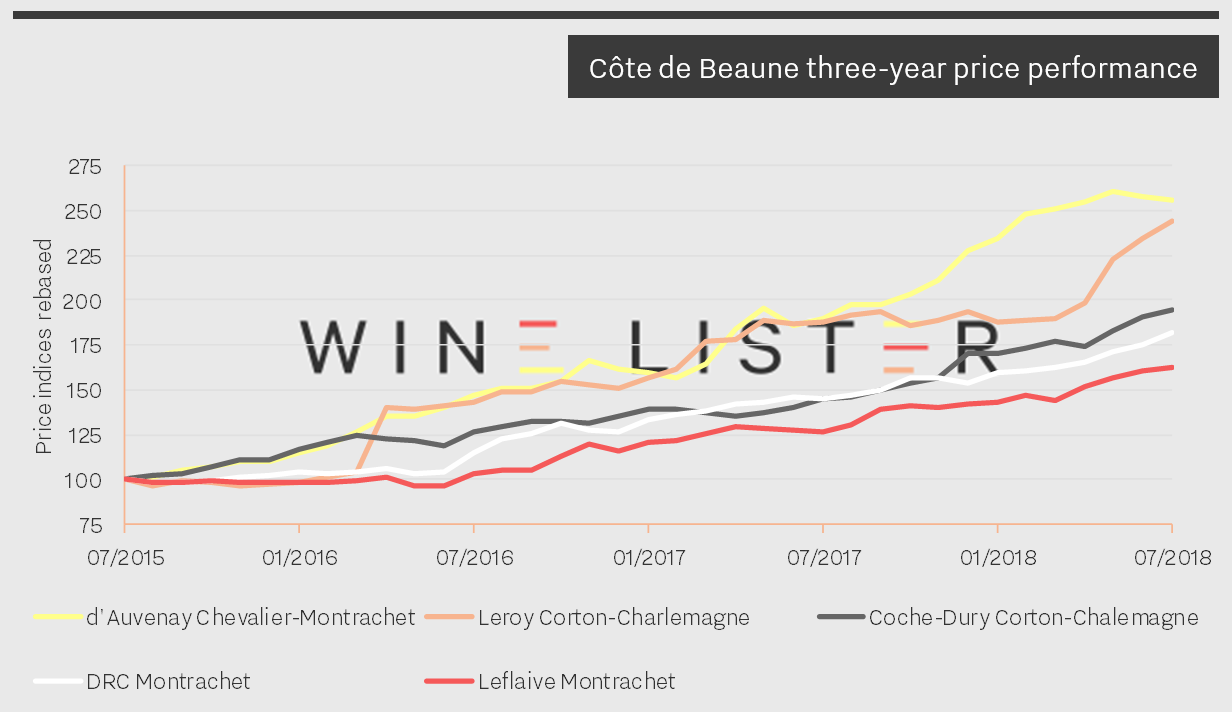
While Europe swelters, the structured reds of Rioja might not immediately spring to mind. However, this summer must surely at some point come to an end, and before we know it, it will be cold, dark, and we’ll once again be reaching for steadying reds. So in the spirit of planning ahead, this week’s Listed section considers Rioja’s five best reds by Quality score.
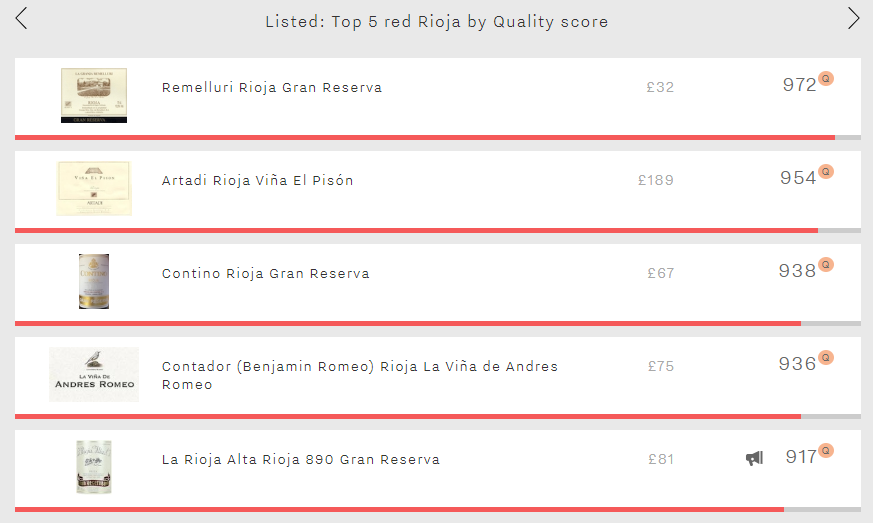
Remelluri’s Gran Riserva comes out on top with a formidable Quality score of 972. Costing on average £32, it is also the most affordable of the five. The 2010, which achieves a Quality score of 977 is available for as little as £35, and with Julia Harding awarding it a score of 18+/20 and calling it “long, dry and already elegant and refined” it seems a lot of bang for your buck.
From the most affordable to the most expensive, in second place is Artadi’s Viña El Pisón (954). Its high price tag is perhaps the result of its low production of on average 6,000 bottles each year. It is remarkably consistent, with its Quality score deviating just 18 points on average from vintage to vintage. 2007 is its best vintage according to Wine Lister’s partner critics, with a score of 985, Julia Harding calling it “(the) essence of Tempranillo”.
Next come Contino’s Gran Reserva and Contador’s La Viña de Andres Romeo, their Quality scores separated by just two points. It is in fact the Contador that is favoured by the critics – the result of superior ratings by Vinous, with for example Josh Reynolds calling the 2010 “a distinctly graceful and seductive expression for this vintage” and awarding it a score of 94/100. The Contino’s marginally better Quality score is thus the result of a longer ageing potential, Wine Lister’s partner critics predicting it to last on average nine years, nearly twice as long as the Contador’s five years.
The remaining spot is filled by La Rioja Alta’s 890 Gran Reserva. Whilst it experiences the group’s lowest Quality score – its score of 917 nevertheless putting it amongst the highest echelons on Wine Lister’s scale – it enjoys the best overall score of the five (851). It turns the tables on the competition in the Brand and Economics categories, both of which it comfortably leads with scores of 792 and 807 respectively.
Having spent the start of the Northern Hemisphere summer focusing on Old World wines of various regions, colours, styles, and prices, this week the Listed section is feeling flush and has journeyed Down Under to take a look at Australia’s five most expensive wines.
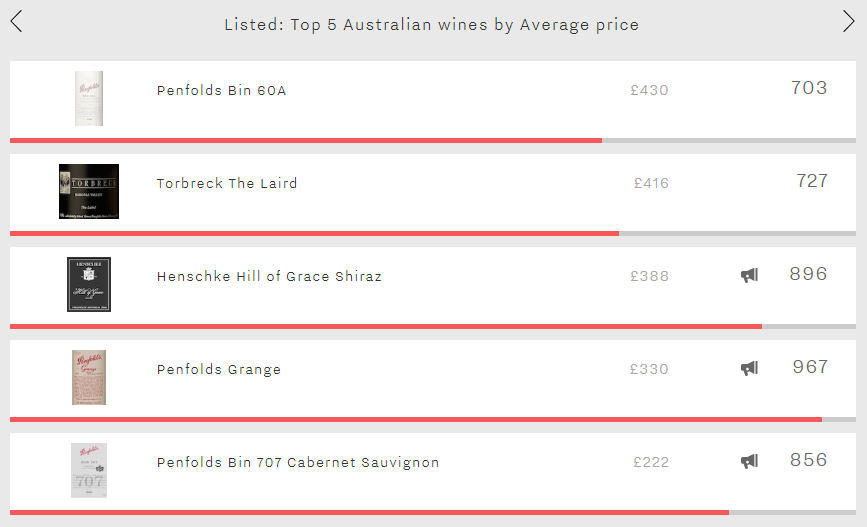
Leading the way is Penfolds Bin 60A at a cool £430 per bottle. The rarest of the rare, this has only been produced twice – once in 1962 and again in 2004 as a reaction to the vintage conditions being very similar to those from 42 years previously. As might be expected given that it is only produced in the very best vintages, the 2004 is a worthy follow-up to the fabled 1962, achieving a formidable Quality score (976). Fortunately, Wine Lister’s partner critics expect it to be drinking well until 2040, which might just give enough opportunity for a third bottling in the meantime.
Penfolds features twice more on the list, with its flagship Grange (£330) and Bin 707 Cabernet Sauvignon (£222). Grange is Australia’s strongest Brand (991) and also enjoys the country’s top Economics score (916). The former is the result of being both Australia’s best-represented wine in the world’s top restaurants (visible in 34%) and also its most popular, receiving on average 21,118 searches each month on Wine-Searcher, four times more than any other Australian wine. The Bin 707 is more of an anomaly in the group, its Quality score (859) over 100 points below the rest. Whilst its Economics score (871) can’t quite match Grange’s, it has comfortably achieved superior growth rates over the past three years, with a Compound Annual Growth Rate of 13% compared to its more renowned stablemate’s 8%.
Australia’s second most expensive wine is Torbreck’s The Laird (£416). First produced in 2005, it enjoys Australia’s best Quality score (984), but, similarly to Penfolds Bin 60A, its Brand score is unable to keep pace (635). This is probably the result of the fact that very few vintages of it are available and it has an average annual production of just 6,750 bottles each year – it is perhaps too young to have built up a significant following and there are not enough bottles of it for restaurants to get hold of.
Rounding off the group in third place is Henschke’s Hill of Grace Shiraz (£388). Again, this has an excellent average Quality score (961). It also achieves Australia’s second-best Brand score (913), present in 19% of the world’s top establishments – sommeliers are clearly very confident in the wine’s quality.
Having recently confirmed Chablis as the place to look for Burgundian Value Picks, this week’s Listed blog brings the price scale up a notch to look at the top five still dry white wines under £200 per bottle by Wine Lister score. Alongside one further appearance from Chablis, the selection is pleasantly diverse.
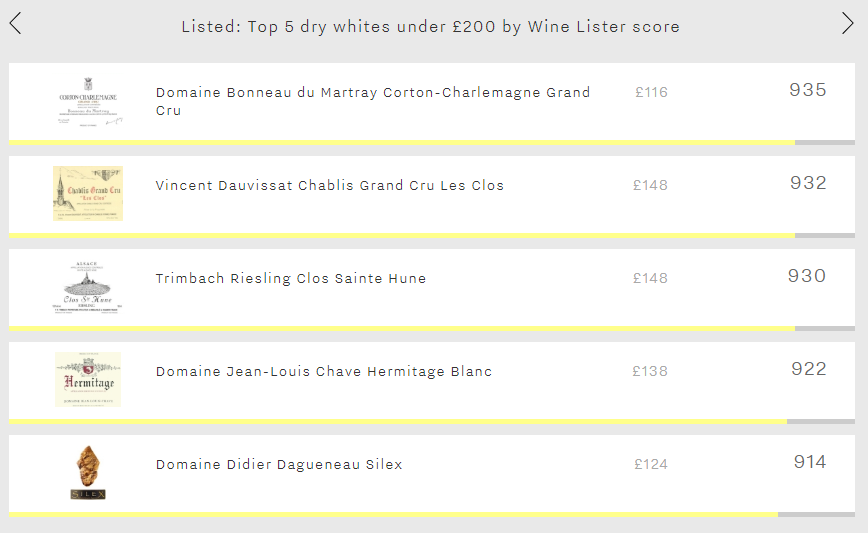
Domaine Bonneau du Martray’s Corton-Charlemagne Grand Cru takes the number one spot. With a market price of £116 per bottle, it is in fact the least expensive of the five. Brand is its strongest category with a score of 950, generated by 4,150 monthly online searches on Wine-Searcher and presence in 36 of the world’s best restaurants. Figures from Wine Market Journal also place it first for trading volumes, with 440 bottles of its top five vintages traded at auction during the last 12 months.
The second-highest scoring still dry white under £200 is Vincent Dauvissat’s Chablis Grand Cru Les Clos. It has both the highest Quality score and market price of the group (952 and £151 per bottle respectively). However, Chablis once again shows a positive price to quality ratio when compared to other white Burgundian offerings with the same Quality score. In this context, Maison Louis Jadot’s Chevalier-Montrachet Les Demoiselles and Maison Joseph Drouhin’s Montrachet Grand Cru Marquis de Laguiche are 42% and 173% more expensive (at £214 and £412 per bottle respectively).
Next on the list is Riesling Clos Sainte-Hune, Trimbach’s most iconic dry white. Its Quality and Brand scores (943 and 947 respectively) outperform its Economics score (870) resulting in an overall score of 930. Clos Sainte-Hune’s tiny production level of an average 9,600 bottles per annum (five times fewer than the 48,000 bottles of Corton-Charlemagne produced by Bonneau du Martray, for example) makes it a true rarity.
Travelling further south for the still dry white in fourth place, we find Domaine Jean-Louis Chave’s Hermitage Blanc with an overall Wine Lister score of 922. Curiously, vintage Quality score variation is more at play here than any other wine of this week’s top five. The 2016 vintage of Chave’s Hermitage Blanc earns the highest vintage Quality score of the lot (993), however 307 points separate its best from its worst vintage (2002) which is also the lowest vintage Quality score of the five.
Last but not least, the fifth highest-scoring still dry white under £200 is Domaine Didier Dageneau’s Silex, with an overall score of 914 and a market price of £124 per bottle. In a regional context, Silex takes the number one spot on all fronts with the highest Quality, Brand, and Economics scores of all Loire dry whites. As the fifth and final wine of this week’s top five, it has the highest restaurant presence with a listing in 39 of the world’s best restaurants.
With England progressing serenely (ahem) through their round of 16 match against Columbia, much Champagne (and probably much more beer) will have been drunk on Tuesday evening. With somewhat tortuous logic therefore, this week’s Listed section focuses on the best Champagnes from the 2000 vintage by Economics score.
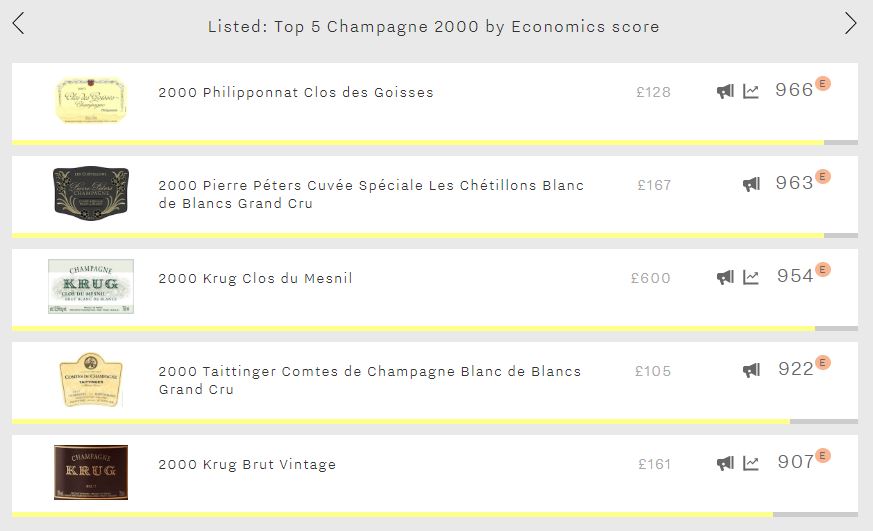
Separated by just three points at the top of the table are Philipponnat Clos des Goisses (966) and Pierre Péters Cuvée Spéciale Les Chétillons Blanc de Blancs Grand Cru (963). Despite experiencing the lowest Quality score of the five – a nonetheless hugely respectable 944 – the Philipponnat gets its nose ahead thanks to excellent growth rates over both the long and short-term, with a three-year compound annual growth rate (CAGR) of 20% and having added 33% to its price over the past six months alone. No wonder it is one of the group’s three Investment Staples.
It is interesting that Pierre Péters Cuvée Spéciale Les Chétillons Blanc de Blancs Grand Cru comes in second place in terms of Economic performance, despite it experiencing the group’s lowest overall Wine Lister score for the vintage (910). Its lower Wine Lister score is the result of its Brand score (822) being the weakest of the group by nearly 90 points, confirming the phenomenal head start that the globally renowned houses have over grower Champagnes in terms of brand recognition. It manages second place in terms of economic performance thanks to formidable short-term growth rates, its price having risen 42% since January.
In third place is Krug’s Clos du Mesnil (954), one of three Blanc de Blancs in this week’s top five, and the first of two wines from Krug, with the Brut Vintage recording an Economics score of 907. The two Krugs are almost inseparable, the Brut Vintage’s Wine Lister score of 967 just one point ahead of the Clos du Mesnil, making them the overall top-scoring Champagnes of the vintage. Our partner critics were barely able to separate them either, the Clos du Mesnil’s Quality score just two points ahead (976 vs 974). However, the rarity of the Clos du Mesnil results in it being over 3.5 times more expensive. Furthermore, with the Clos du Mesnil recording a 3-year CAGR of 14% and short-term growth rates of 12%, the price discrepancy is increasing – the Brut Vintage has a 3-year CAGR of 8% and has increased in value by 4% over the past six months. However the feather in the cap for the Brut Vintage is that it is considerably more liquid – presumably because of larger production volumes – its top five vintages having traded 1,279 bottles at auction over the past four quarters, over 11 times as many as the Clos du Mesnil (112).
The remaining spot is filled by Taittinger Comtes de Champagne Blanc de Blancs Grand Cru (922). It is the second-most liquid of the group, its top five vintages having traded 720 bottles at auction over the past year.
Incidentally, 2000 was a European Championships year, not a World Cup year. Fittingly, given the focus of this blog, France won. England failed to make it past the group stages.
As a sort of postscript to the difficult 2017 en primeur campaign (read our CEO Ella’s thoughts here), over the past week or so Pomerol powerhouses Petrus and Le Pin were released at £1,480 and £1,750 per bottle respectively. With Pomerol wines achieving the top three Quality scores of all reds for 2017 – and five of the top 10 – it was the top-performing red appellation of the vintage.
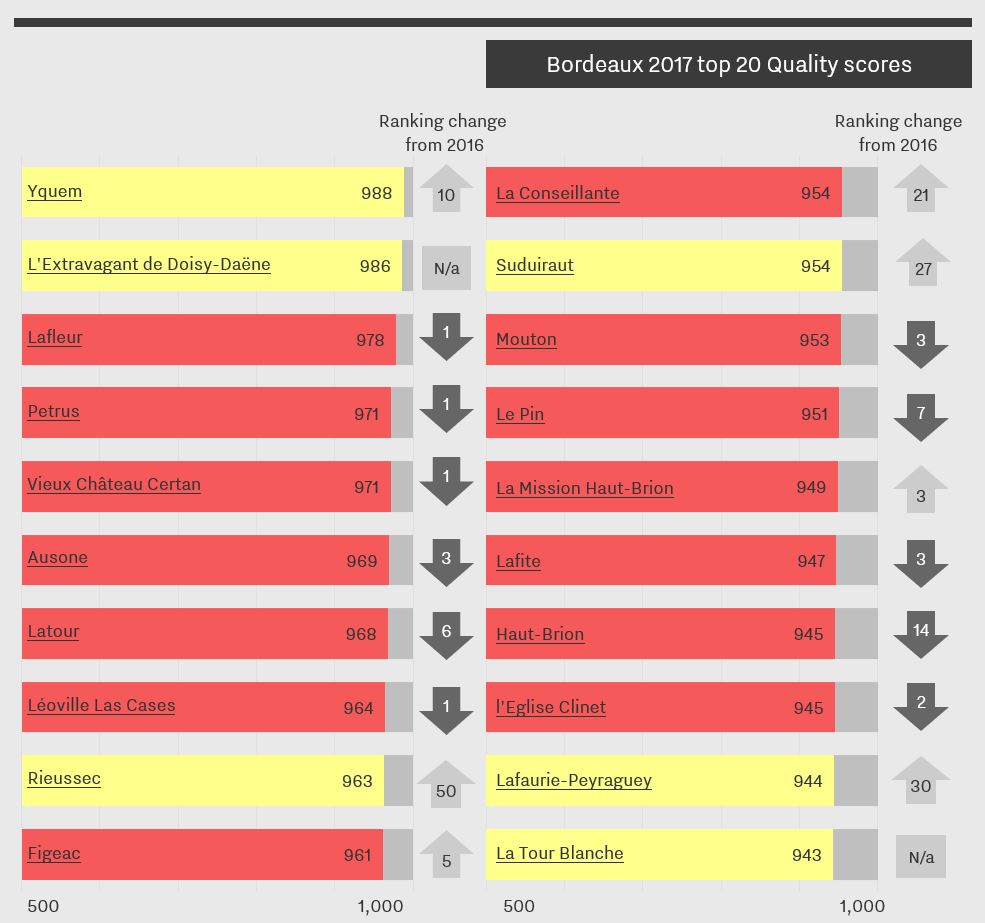
Now that we have release prices for all of Pomerol’s top wines, we can see which came out on top in terms of overall Wine Lister score*.
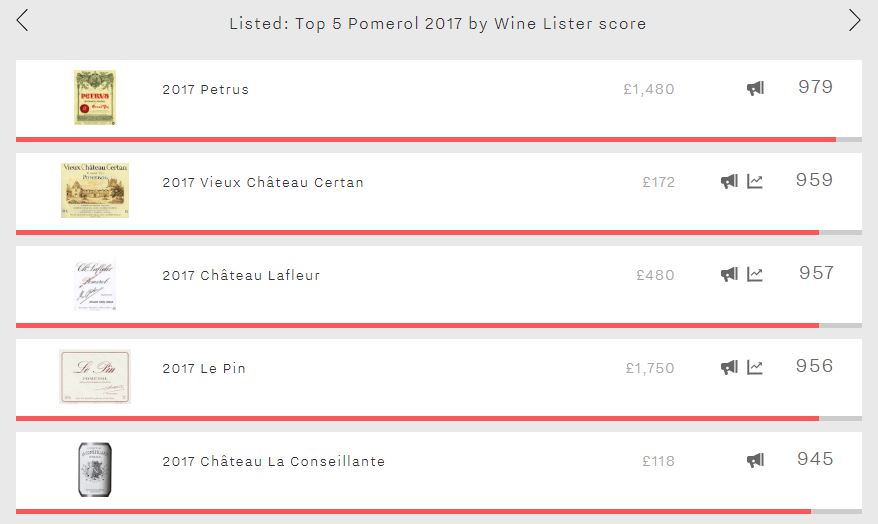
With a score of 979, Petrus was not just Pomerol’s leading wine of 2017, but the number one wine in Bordeaux. This is perhaps unsurprising given that it received the joint-second best Quality score of the vintage of all reds (971) – alongside Vieux Château Certan – and also has a Brand score of 998 (beaten only by Lafite, Latour, Mouton, Yquem, and Dom Pérignon Vintage Brut) along with a wine-level Economics score of 978 (third-best in Bordeaux). With Wine Lister’s Founding Members voting it the second-most prestigious wine in the world in a recent survey, behind DRC La Romanée-Conti, Petrus is currently unbeatable in Bordeaux.
Number two on the 2017 Pomerol leaderboard is Vieux Château Certan (959). While the confidence rating attributed by Wine Lister’s Founding Members slipped a point over the past year from 9/10 to 8/10, it nevertheless achieves Pomerol’s second-best Brand score (972). Thus, despite its relatively modest Economics score (909) – still putting it amongst the very best on Wine Lister’s 1,000 point scale – the 2017, thanks to its excellent Quality score, manages to edge just ahead of Lafleur in terms of overall Wine Lister score (957).
Lafleur 2017, the best red wine of the vintage for Quality (978), was released in early May at £430 per bottle, a 7% decrease on the 2016 release price. This was Neal Martin’s favourite of the five, Wine Lister’s newest partner critic awarding it a score of 95-97 /100 and commenting: “This is an awesome 2017 from Baptiste Guinaudeau, one of the few that will oblige several years in the cellar”.
Le Pin 2017 was released in the UK at £1,750 per bottle, its 25% decrease on the 2016 release price the largest year-on-year reduction of the five. It experiences the lowest Quality score of the five for the vintage (951), and also has the group’s lowest Brand score (944). The fact that the 2017 betters Lafleur and La Conseillante in terms of overall Wine Lister score is thus the result of its formidable Economics score (980), which it achieves not just because of its high average price but also strong growth rates, which are the best of the group over both the long and short-term.
Rounding out the group is La Conseillante (945). Whilst it is by far the most affordable of the group, it is the only one of the five whose 2017 climbed the Bordeaux Quality score table compared to 2016, surging 21 spots to be the eighth best red and 11th best overall.
Remember that you can catch up on all of the campaign’s releases on our dedicated en primeur page.
* Please note that overall Wine Lister scores for en primeur wines use estimated Economics scores based on the performance of back vintages.
What do you do when your drinking tastes far outweigh your wine budget? You could trawl the shops and the internet in search of that bottle that combines high ratings and moderate prices, or alternatively you could use Wine Lister’s Value Picks search tool. It selects top quality wines that are available at reasonable prices, doing the legwork for you. This week’s Listed section shines a spotlight on the top five reds that currently qualify as Value Picks. At present, they are all Tuscan, all available for under £90 – in fact all but one cost less than £50 – and all have Quality scores of over 990, putting them amongst the elitest of the elite on Wine Lister’s 1,000 point scale.
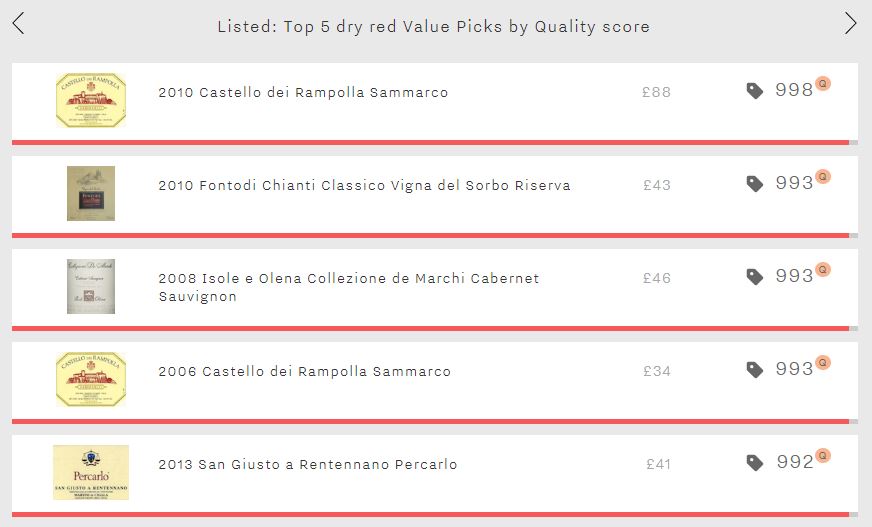
If you are after exceptional value, then look no further than Castello dei Rampolla’s Sammarco. With two vintages in the top five (2010 and 2006), each of which have plenty of life still left in them, they look like wise purchases. The 2010 owes its exceptional Quality score to a perfect 100-point rating from Wine Lister partner critic Antonio Galloni, who called it “stunning as it has always been. In a word: magnificent!”. At £88 per bottle, it might not be the cheapest, but it does look good value compared to the two other 998-point scorers from Tuscany 2010: Cerbaiona Brunello di Montalcino (£248) and Castello dei Rampolla’s Alceo (£128).
Whilst the 2010 is not quite ready to drink, the 2006 has just entered its drinking window. Underlining the wine’s longevity, Galloni, who awarded the wine a 97-point score, remarked: “Readers will have to be exceedingly patient here. There is no denying the 2006’s greatness, though.” The 2006 will be drinking well until 2036, and available for as little as £34 per bottle, looks like an excellent long-term investment (if you can refrain from opening it).
Flying the flag for Chianti is Fontodi’s best ever Chianti Classico Vigna del Sorbo Riserva – the 2010 (£43). Whilst its Quality is not in doubt, its economic performance is slightly less impressive, its price having fallen 11% over the past six months.
The remaining spots are filled by Isole e Olena Collezione de Marchi Cabernet Sauvignon 2008 (£46) and San Giusto a Rentennano Percarlo 2013 (£41). Isole e Olena Collezione de Marchi 2010’s Quality score is the furthest above its wine-level average Quality score (993 vs 934) of the five. The market has not yet reacted to this standout vintage, its price being no different to the wine-level average price. Meanwhile San Giusto a Rentennano Percarlo 2013’s Quality score is the closest to its (formidable) wine-level average (992 vs 967), yet its price is 36% below the wine-level average, underlining the 2013’s excellent value.
Please note that prices shown are excluding duty and VAT, and often reflect prices available only when purchasing a full case. They are provided by our price partner, Wine Owners, whose own proprietary algorithms process millions of rows of incoming price data from Wine-Searcher to calculate a more realistic market level price – the price at which a wine is likely to find a ready buyer – based on market supply and spread models. As lower retail prices are likely to sell first, the prices you see on Wine Lister may be below the Wine-Searcher average in some instances.
Often overlooked in favour of Burgundy’s top whites, the Rhône’s counterparts should not be forgotten, particularly if you’re looking for a rich style at a more reasonable price. Whilst the Rhône’s top five dry whites for Quality can’t match the scores of Burgundy’s top chardonnays (930 vs 977), they are nearly 30 times cheaper on average (£126 vs £3564). Within the Rhône, in the battle of North vs South it is the former that comes out on top, with four expressions of Hermitage featuring in the top five.
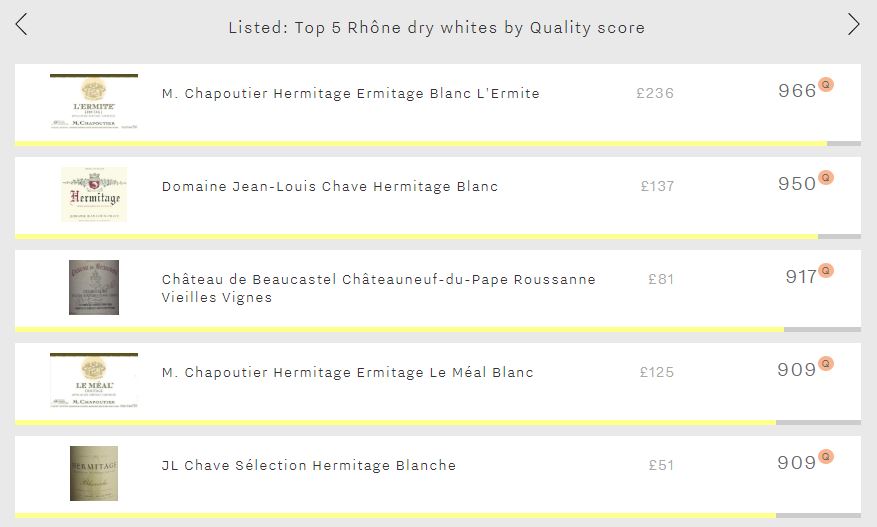
Leading the way is Chapoutier’s Ermitage Blanc L’Ermite (966). By far the most expensive of the five, it is particularly favoured by Bettane+Desseauve, the French duo awarding it an outstanding average score of 19/20. It is also the longest-lived of the group, alongside Domaine Chave’s Hermitage Blanc, with an average drinking window of 12 years. Despite its outstanding Quality score, it experiences the lowest overall Wine Lister score of the group (799), its Brand and Economics scores failing to keep pace (659 and 666 respectively).
In contrast to Chapoutier’s L’Ermite, Domaine Chave’s Hermitage backs up its excellent Quality score with the best Brand and Economics scores of any Rhône white (930 and 873), propelling it to first place in terms of overall Wine Lister score (927). It is Vinous’ favourite of the five, with an average score of 95/100, helped by a score of 97-99 for the 2015, Josh Reynolds stating that it shows “a remarkable interplay of depth, power and energy that I only occasionally encounter with the very best white Burgundies”.
Interrupting Hermitage’s hegemony is Beaucastel’s Châteauneuf-du-Pape Roussanne Vieilles Vignes (917). Proving that the appellation’s best whites can compete with their red counterparts, it outperforms Beaucastel’s straight Châteauneuf-du-Pape in the Quality category (917 vs 876). However it can’t quite beat the domaine’s flagship Hommage à Jacques Perrin (962), but at under a third of the price (£81 vs £255) it does look better value.
Two more Hermitages round out the group, another from Chapoutier – Le Méal Blanc – and, impressively, one from Chave’s négociant label – Hermitage Blanche – each with a Quality score of 909.
In this week’s top five, we take a break from June’s Bordeaux bias on the vinous calendar to look at the rising prices of Tuscany’s top wines.
However, there’s no escaping Bordeaux with Tuscany’s most expensive wine, since Masseto is distributed through the Place de Bordeaux. With tiny quantities available to purchase via the Place each year – average annual production is 32,000 bottles – Masseto’s price of £511 per bottle makes it well over a third more expensive than the rest of this weeks’ top five, and also the second-most expensive Italian wine on Wine Lister (beaten only by Giacomo Conterno’s Barolo Monfortino Riserva).
Masseto also achieves the group’s best Brand score (977), the result of featuring in the highest number of the world’s top restaurants (24%) and being over 2.5 times more popular than any of the other four. The chart below confirms a strong relationship between Brand score and price for these wines, with Masseto’s formidable brand strength playing a key role in its high price.
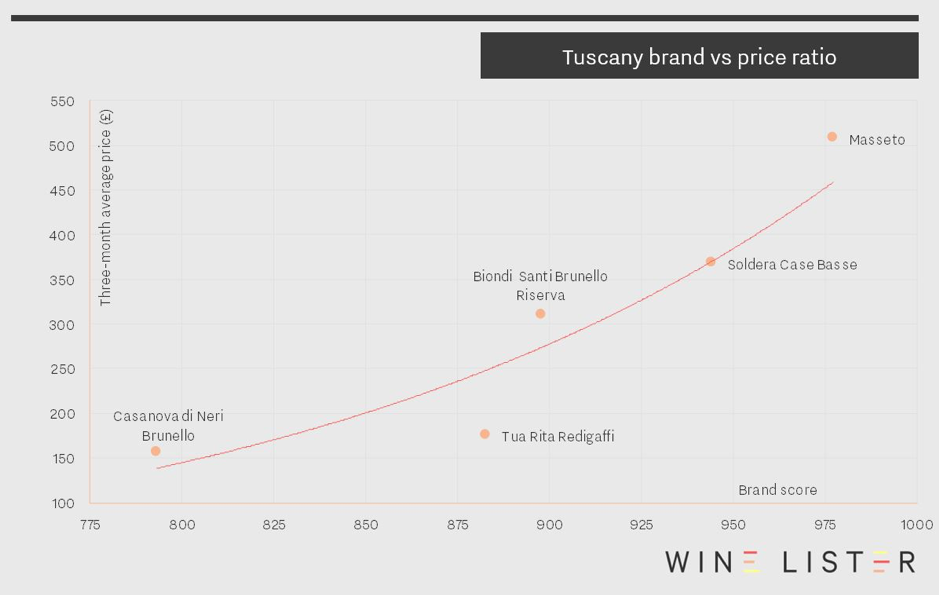
At £367 per bottle, Soldera Case Basse Sangiovese takes the second spot. It achieves the highest Quality and Economics scores of the five (976 and 957 respectively). With an impressive three-year compound annual growth rate (CAGR) of 18.4% – by far the highest of the group – and having added 7.3% to its value over the past six months, Soldera Case Basse continues to cement its position as Tuscany’s second-most expensive wine, and close the gap on Masseto.
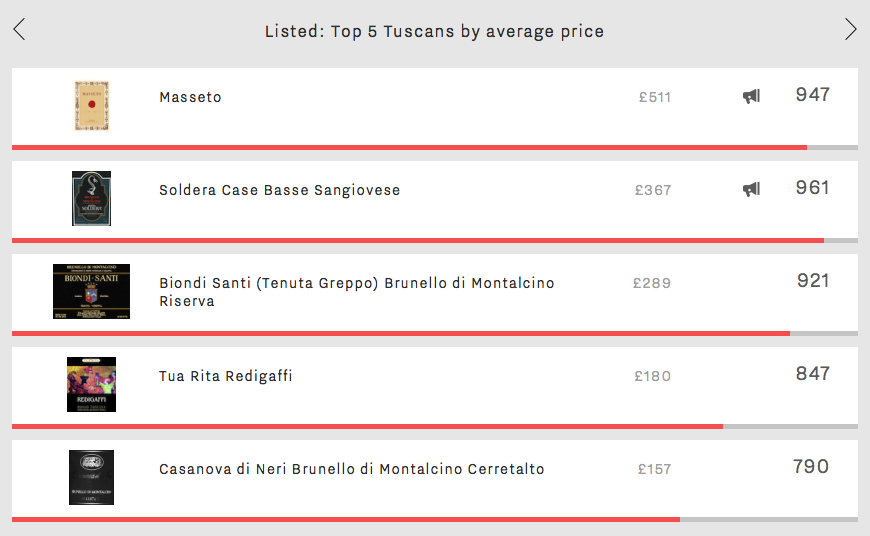
Two Brunellos feature amongst Tuscany’s most expensive wines: Biondi Santi’s Brunello Riserva (£289) and Casanova di Neri’s Brunello Cerretalto (£157). Whilst Biondi Santi Brunello Riserva’s appearance might be expected, considering its heritage, the fact that Casanova di Neri Cerretalto is amongst Tuscany’s most expensive wines might be more of a surprise, indicating that Riserva status alone does not currently guarantee higher prices than straight Brunellos.
Rounding out the five is Tuscany’s fourth-most expensive wine and the group’s second 100% merlot – Tua Rita’s Redigaffi. At an average price of £180 per bottle, it is over 2.5 times cheaper than its varietal companion in the group, Masseto.












